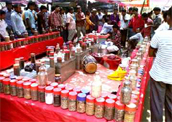Jawad Hossain Nirjhor for The News Today
 This article is about alternative medical practices that are adopted by poor people suffering from myriad illnesses, giving us a glimpse of the health conditions and sufferings of the underprivileged population in this country.
This article is about alternative medical practices that are adopted by poor people suffering from myriad illnesses, giving us a glimpse of the health conditions and sufferings of the underprivileged population in this country.
Afsar Ahamed lay near a corner of a street in Hatirpool, huddled in pain. He was gasping for breath desperately when I walked past him. Deeply suffocated, Jafar was trying to breath so hard that he was overstretching his body muscles to draw in air. He barely managed to whisper hapani and Ticamet 250 when I enquired. A couple of bystanders explained that the man was an acute asthma patient. He had run out of an inhaler and on his way to Mohammadpur he had fallen into an attack. Understanding the gravity of the situation, I quickly purchased a Ticamet 25O inhaler from the nearest pharmacy, shook it hard and gave itto Jafar. When he took the first puff, the gasping slowed down. He quickly turned to me to offer a word of thanks, as best as he could. Such incidents occur quite frequently but the poor patients like Jafar are unable to afford the costly inhalers. Jafar, a resident of Kutuber Bosti in Khilgaon, has been an asthma patient for more than 12 years. Previously, he had suffered from Tuberculosis, or TB, and treated himself at the TB hospital in Chankharpul. Asthma was a follow up to the TB. He needs three inhalers amonth. A Ticamet 250 inhaler that lasts 120,puffs costs Tk 800. Jafar’s family barely earns Tk 100 a day by feeding rickshaw pullers in a mess, and he cannot afford to purchase the inhalers. A good man in Mohammadpur gives him one inhaler every month. Jafar rations that to survive whenever he has an attack. His last inhaler had run dry three days ago and he was on his way to Mohammadpur to fetch another one when the attack came. Unable to bear the medical expenses of conventional treatment methods, Jafar opted for alternative practices. The first treatmentwas eating frog’s liver. A female kobiraj (‘healer’ without any professional training) in his village in Bhola had administered the treatment. The remedy was supposed to cure the lungs.The second treatment Jafar received was in Tongi. This time, another kobiraj made him drink tea with a cockroach in it. The belief was that it would clear the breathing. The treatments did not bear fruit and Jafar has had to struggle ever since.Belief at Work The High Court mazaar (mausoleum) area is a home to a good number of kobiraj. They specialise in treating jaundice. What they use is a garland made of green shoots of a tree locally known as ‘bilaihachra’. The tree grows in the adjacent National Eidghah field. The garland is made using a special knot called the baisha knot and it is placed on the patient’s head. Thetreatment is predicated on the belief that the body soaks in juice from the garland. As jaundice in the body is gradually cured, the garland expands in size and ultimately falls off the head. This act is cited as a grace of God. Alternatively, the garland might as well expand due to a gradual loosening of the knots over time- as the shoots dry and shrink. In addition to the garland, a special herbal medicine is given. The liquid, which has two different versions for kids and elderly people, is a certified herbal remedy for purifying the blood sold in the local market. Some kobiraj also tie a special amulet on the abdominal region. The amulet contains the elephant faeces that is collected from Dhaka Zoo. It is believed that anelephant’s faeces contains healing properties and extracts bad water from the body of a jaundice patient. Kobiraj Nazim sits in the open Eidgah field adjacent to the mazaar. When I approached him, he quickly grew impatient and reproachful towards me. To substantiatehis claim of the healing properties of his method, hesaid, “The cure depends on imaan (faith); if you do not have strong faith, it does not work on you.” I asked some of the local people about the medical practice, but none could ascertain that the method actually works. The recipients of this treatment are the very poor people who, unable to pay for conventional treatments, are more than ready to take a leap of faith. There are also some ignorant patients who blindly believe that such treatments work. One such kobiraj has a female relative working in a government hospital. Sometimes the relative sends poor patients from the hospital to him. A kobiraj in the High Court area makes Tk 50-300 a day from attending four to five patients. The mazaar offers free food to the poor everyday at lunch. Sometimes, kichuri and biriyani are doled out in the morning. The area attracts a good number of poor people, some of whom are patients. The kobiraj survive between their meagre income and the free food. The Stones Use of stones is another form of unconventional treatment. Unlike other methods, the stones are both a proactive and reactive cure that can, as is believed, both heal and prevent illness. Stone sellers sit on the footpath in various areas in Dhaka, exhibiting a wide array of stones in rectangular glass and wooden boxes. Apart from stones, they also sell printed copies ofverses from the Holy Quran and miniature Holy Qurans measuring only one square inch in dimension. At first, such a small Holy Quran looks marvellous, but a close look at it shows that it is only a work of a computer word processor where an ultra small font has been used and numerous copies printed per page and cut into pieces. The writing is not legible .The stones sold on the footpath are inexpensive ones, cut into shapes and polished to give a shine. Some stones are synthetically manufactured. Different stones, which are named by colour and shapes, are believed tohave different healing properties.I met Karim Shah Chishti selling stones near Matshya Bhaban. On my query, he defensively answered, “I only sell stones that people want to buy or are prescribed by astrologers. The stones are a grace of the Almighty and works with his blessings.” His customers are the poor people and the prices of the stones range fromTk 5 to Tk 500.I met one customer suffering from rheumatism. He already had two stone rings on his fingers and was purchasing a third one.Mr Chishti informed him that the akik stone ring he had been wearing for two years was a fake one. On the purchase of a small stone, when the customer was not willing to pay good price, Mr Chishti said, “Pay as much as your imaan wills.” The Modern Day Kobiraj In Mohammadpur, I met one kobiraj who administers treatment over mobile phone. The kobiraj, unwilling to disclose his name and mobile phone number to me, said, “I read out Surah Náas and the last three verses of Surah Hashr from the Holy Quran over the phone to treat body illness. The phone must be placed over that part of the body where the illness lies. If I read out the verses and blow over the phone the illness is cured by the grace of God.” I met one patient who placed her mobile phone over her knees to treat a pain while receiving the treatment. I could not find any patient with claims of proven results from the treatment. In Goran, I met another herbal medicine doctor who claimed to have the power to treat cancer. Dr Elias of Koshba Homeo Hall in South Goran claims to prescribe foreign herbal drugs to cure cancer. Among other drugs, he mentions ‘shark cartilage’ as the principal medicine to cure tumorous growth. On the walls of his chamber hang testimonies of patients who have supposedly been cured of cancer. However, on my two visits to the premises, I failed to locate any cancer patient. Unani And Herbal Medicine The Bangladesh Unani and Ayurvedic Practitioners Ordinance of 1983 in the constitution guarantees a legal status to traditional medicines. Traditional medicines and medical practices in South Asia are the most commonly used means of treatment for poor people. Unani and Ayurveda have a long history of treating diseases and ailments.Presently, Hamdard (Wakf) Laboratories is the largest producer of Unani medicine in Bangladesh. It is also the largest producer of Unani medicine in the world. There are many other herbal medicine producers located in Narayanganj and Gazipur. Under the Unani system, a Hakim does not charge any fee for visits; he only charges for the medicines he prescribes. The Unani medicines are also relatively cheaper compared to their allopathic counterparts. As such, the method is widely availed by the poor. There are many herbal and homeopathic clinics in Dhaka that have been treating patients for more than two decades.Medicines such as Alisa, Dpiles and Ginseng are prescribed in these clinics that can permanently cure asthma, piles and sexual ailments respectively without any form of surgery. Hamdard (Wakf) Laboratories has many medical centres throughout Bangladesh where free treatment is given to the poor once a week. However, while the application of the Unani practice is widespread, the success is not evident in all cases. In March 2005, a Health Canada report on Safi, a popular herbal syrup,stated that Safi was ‘found to contain arsenic levels in excess of 40 times the maximum allowable concentration for drugs’.The Reflection Due to rising medical costs against limited income, coupled with religious beliefs, tradition and ignorance, poor people adopt alternative medical practices. While Unani and herbal practitioners have drug licenses and medical certificates, most kobiraj treating countless diseases do not have the income to file for license which would impose VAT upon them. Poor people are often illiterate and the actual experience they get from the treatments is unaccounted for. The government and health authorities should investigate these alternative medical practices. Practices that are scientifically ustified and productive should be integrated with the mainstream medical system to create greater awareness about them; practices that are not proven to have proper remedies should be quashed with strong force.

